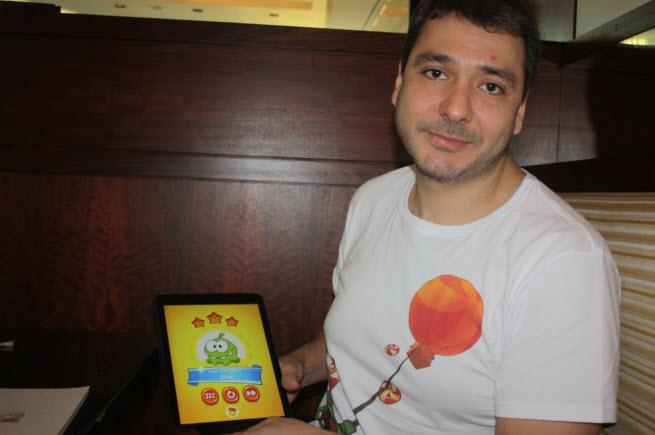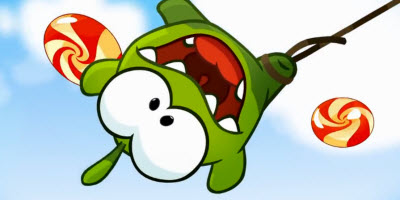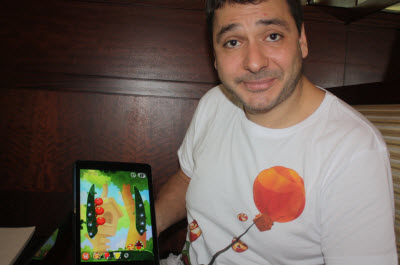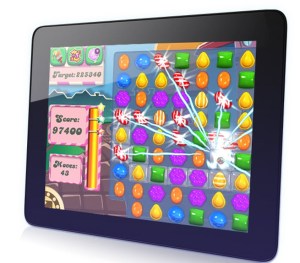GamesBeat: We’ve seen a lot of knockoffs, too.
Lyalin: We don’t pay too much attention to that. Well, we do when the game is ugly. We try to take those down. But when somebody does a nice clone, we’re completely for that. We might even learn something from it.
GamesBeat: Did you learn anything about some of the different territories here?
Lyalin: Certainly. For us, it’s very different. First of all, we opened up an office in Shanghai. In China and the Asian markets we have a completely different structure. In China, everything we’ve done has been free. We’ve not done anything premium in China, because there’s no point. The messengers are growing in a big way, so Cut the Rope will take advantage of some of the dynamics that are happening there in Asian markets. We’ll be launching different versions for different platforms, too.
GamesBeat: I went to a conference in Finland, where Ilkka Paananen, the CEO of Supercell (maker of Clash of Clans) was saying that they don’t really change their game for different territories. They keep the game the same. Are you thinking in the same way, about making a universal game?
Lyalin: No, we change the game. In fact, for the Chinese market, we’ve released special content and packaged the game differently. For some people, they don’t have to change everything. For us, this is a very casual experience, and a casual experience is different in every part of the world. When you’re aiming to get 10 million people or 20 million people, it’s one thing. When you’re aiming at a billion people, it’s another. That’s why we have to be very culturally different in every market.
Specifically, here, we’re launching as a paid game on Apple for Christmas. It’s a special, an introductory special, a sale at 99 cents for iPhone and iPad. We haven’t done this before. It’s because in this market, we think there are tens of millions of people that have experienced a game like this before, so we want to keep that experience.
GamesBeat: Does Angry Birds provide you with any kind of model? Merchandising is a big part of their business.
Lyalin: We look at everybody. It’s our model. Merchandising is big, true. They were certainly an inspiration for what we’ve done there. But our business is very different. They’re very different games. Ours isn’t about a big fight. It’s about physics and cute characters and solving problems. That creates different licensing opportunities.
GamesBeat: What’s included in the plan for how to make this take off and become even bigger? Is there a strategy that’s very distinct?
Lyalin: We have a marketing campaign going on with “Om Nom is missing.” We’ve put posters around the cities and done some social media as well. But what’s most important is, within our games we have something interesting. In all of our games today, Om Nom will go missing. You play a little bit and then he’ll disappear, and it will pop up the notice, “Om Nom is missing!”
There are some big events going on today. There’s one in London, one in Paris. But the most important marketing is going to happen within our games, where tens of millions of people will see that “Om Nom is missing!”
GamesBeat: How do you guys design characters like this?
Lyalin: All these characters, the new ones, all of them interact with Om Nom and the different objects. We try to design them based on what they actually do. This one just multiplies, so he looks like somebody who’s very grumpy and weird. This one is a bomb; it explodes and makes Om Nom move. This one has a huge tongue, and it can swing across the screen. You can use different objects on the tongue. This one, called Toss, can toss any object – Om Nom, anything.
GamesBeat: But they’re always appearing on screen with Om Nom? They don’t replace him.
Lyalin: No, they don’t. Om Nom still eats the candies. They’re helpers, helping him get un-lost.
GamesBeat: If someone wants to spend in the game, what will they be buying?
Lyalin: They’ll be buying some of the power-ups, obviously. They’re there to help you. You can get solutions, get balloons. You can win them as well, though. You don’t have to buy them. You can get candy rain. There’s a shop where you can buy all this stuff in different packages. You can also dress up Om Nom. For example, we have a Christmas set. You can make him into a superhero. We’ll be giving some of those away as well. You can even customize the swoosh if you want.
Right now, it’s a paid game. It’s a premium game. We haven’t made the different mechanics work to make it free. So you don’t have to buy power-ups. You can complete the game without them. But they’re fun.
GamesBeat: What are you thinking about how mobile games have changed each year? We’ve noticed that the top rankings keep changing. Angry Birds hasn’t stayed up there forever. Clash of Clans, Puzzle & Dragons, and Candy Crush have come along. They’re sticking for a longer time sometimes, but it’s still not very predictable to me.
Lyalin: The market is changing. It’s maturing. A lot of games that are very hardcore in nature have showed up on the platform, and they’re very different from the casual games that used to dominate. However, it’s all going to change again.
We look at our business differently. We’ve been consistently growing, and not just in the number of downloads. It’s about usage. It’s about people playing the game. Those numbers have constantly grown. We don’t make a lot of money from every player, but that will change as well with different monetization mechanisms. Plus, advertising is something that doesn’t go into the top-grossing charts, but it can make up a big portion of your revenue. That’s going to continue.
We’re very different from a lot of others out there, because we’re not just about traffic. We’re a brand, and when you’re a brand you have really interesting co-branding opportunities. That’s what we’re moving toward with advertising. We want to make advertising more contextual and fun for users, as opposed to just banners and pop-ups.





